This post may contain affiliate links. Please read our disclosure policy.
Get creative and make a beautiful, longevity peach bun made with a combination of white and green dough. This bun is the perfect birthday bun to symbolize longevity. It is the ideal sweet snack packed with Red Bean Paste that can be enjoyed anytime.
What Is A Longevity Peach Bun?
A longevity peach bun symbolizes immortality or longevity. It represents the Peaches of Immortality that immortals consume, according to Chinese mythology.
Legend has it that this special peach only becomes ripe once in a thousand years and can make people immortal when eaten.
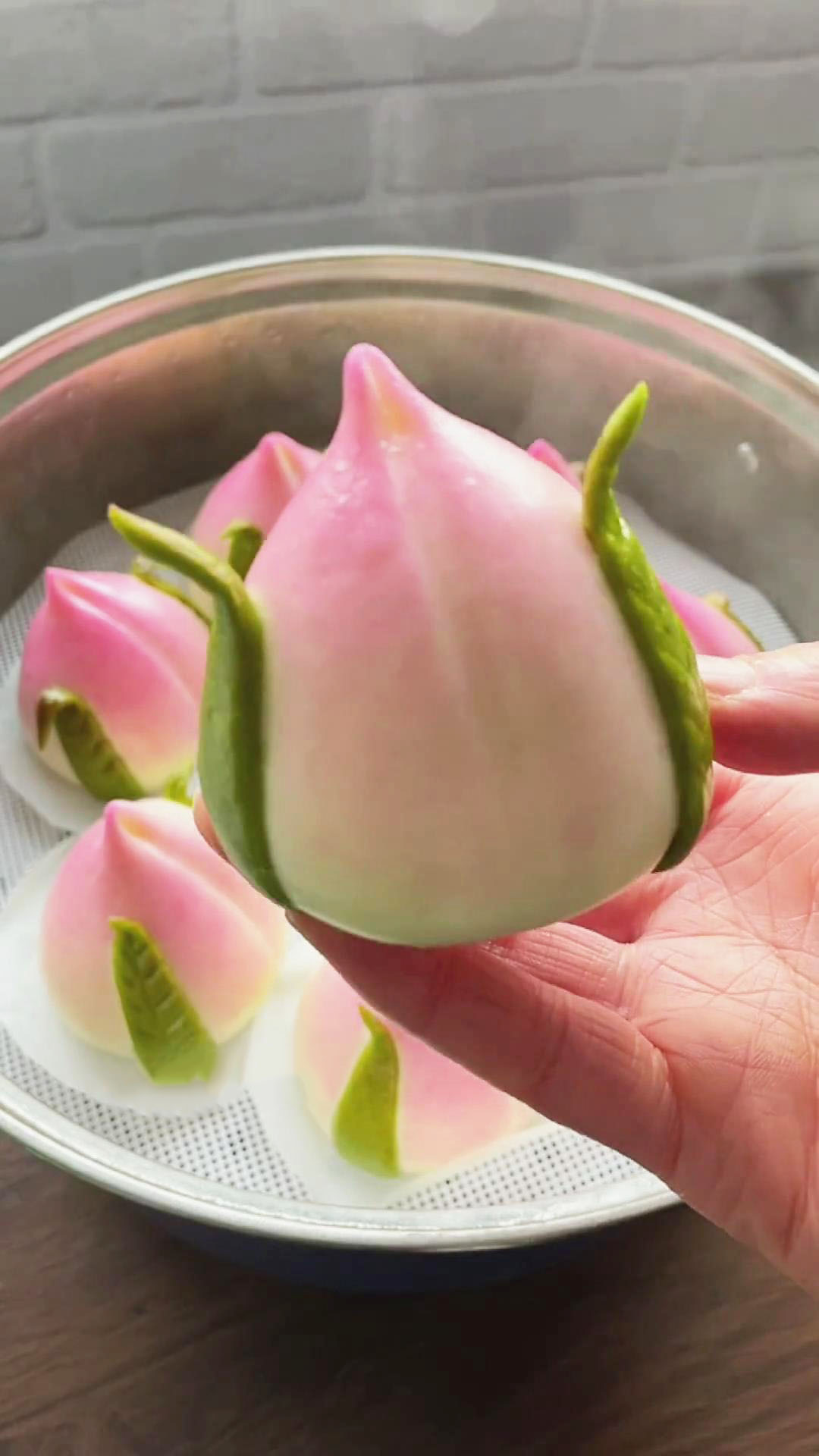
Today, a longevity peach bun is typically served on special occasions such as birthdays, holidays, and weddings.
Moreover, it is often offered to elderly people to celebrate reaching an old age. To make this bun look like an actual peach, I use two colors of dough: white and green.
The white dough is used as the peach shape, while the green dough is for the leaves. As for the filling, red bean paste is typically used for this, but you can also use your own choice of filling.
Some examples of fillings to use for more variety of flavors are taro paste, yam paste, lotus seed paste, purple sweet potato filling, and custard.
Ingredients For Longevity Peach Bun
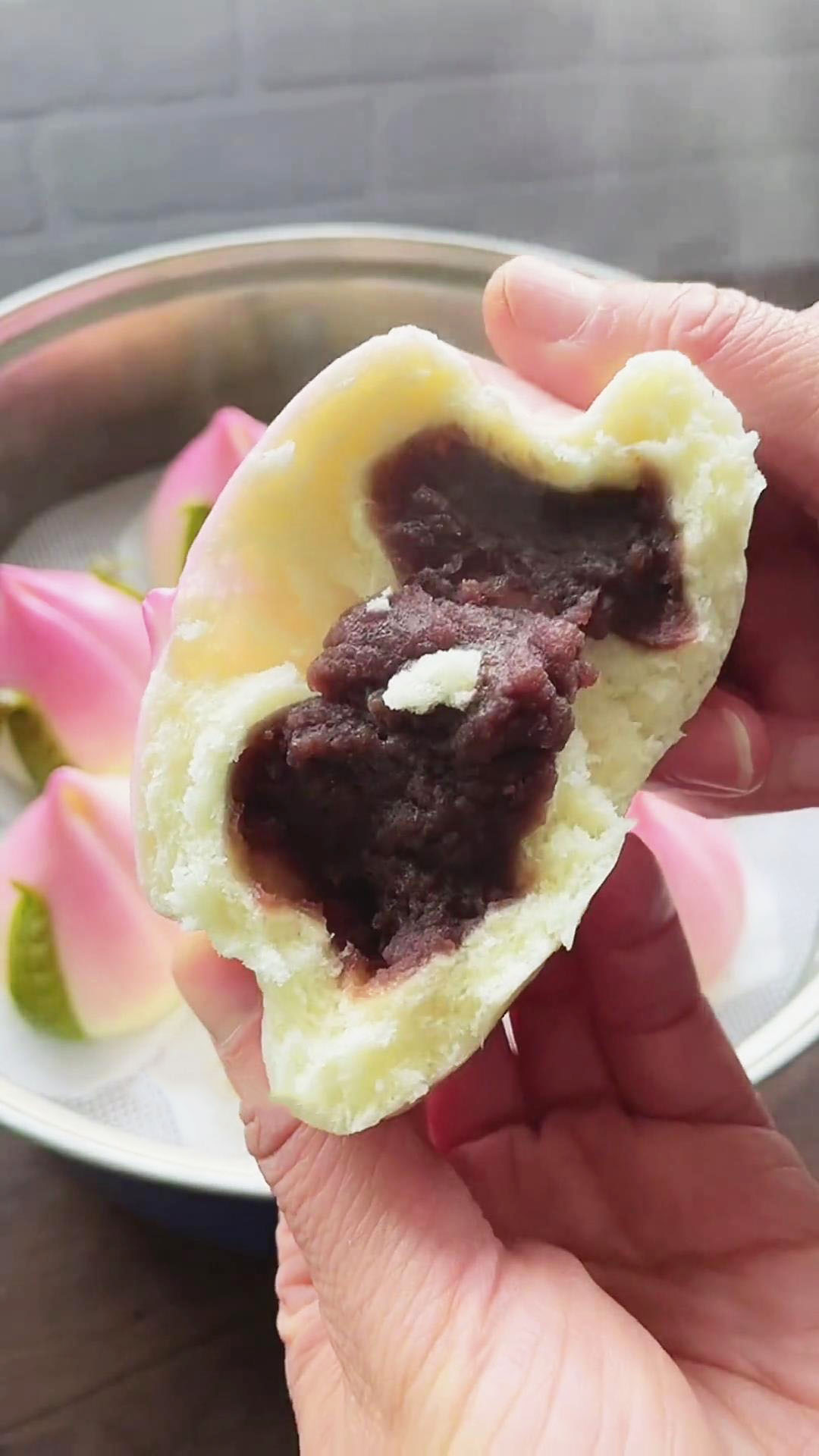
You will need two separate dough ingredients for white and green dough. Before you get started, I suggest reading a little bit of information about each ingredient.
I share some alternatives you can use and the purpose of each ingredient. Check out the ingredient details below:
For The Dough
- All-Purpose Flour: A mixture of all-purpose flour or regular flour and water will produce pale-colored, airy, and soft buns.It is best to avoid special flour types such as whole wheat flour, rice flour, or glutinous rice flour. These flours will alter the texture of Chinese buns. Whole wheat flour, for example, makes a denser texture, while glutinous rice flour produces a sticky and chewy texture.
- Yeast: Making buns rise requires this ingredient. The buns will remain flat and dense without yeast. There are two types of yeast: instant yeast and active dry yeast. When using instant or fast-rising yeast, you can mix it directly with the flour and warm water. When adding active dry yeast to the flour mixture, you must first mix it with warm water.
- Warm Water: Warm water plays an important role in activating yeast. It is not recommended to use hot water that is between 120°F and 140°F or higher. Yeast will die in hot water! The activation process cannot begin once the yeast is killed. As a result, the buns will not rise and will remain flat. Make sure you use warm or lukewarm water by measuring the temperature with a thermometer to avoid this troublesome situation.
- Spinach Juice: For the green dough, I use spinach juice instead of water for the green color. If you don’t have spinach juice, you can use other green-colored juices like green apple, lettuce, kale, and arugula.
- Prickly Pear Fruit Powder: This ingredient is not exactly mixed with the dough mixture but as a topping for color. Mix this with a bit of water and lightly dust it onto the shaped buns for a pink-colored peach. You can use other vegetable juice with a pink hue as an alternative. This pink powder is optional only for a beautiful pink color.
All About Kneading And Proofing A Bun
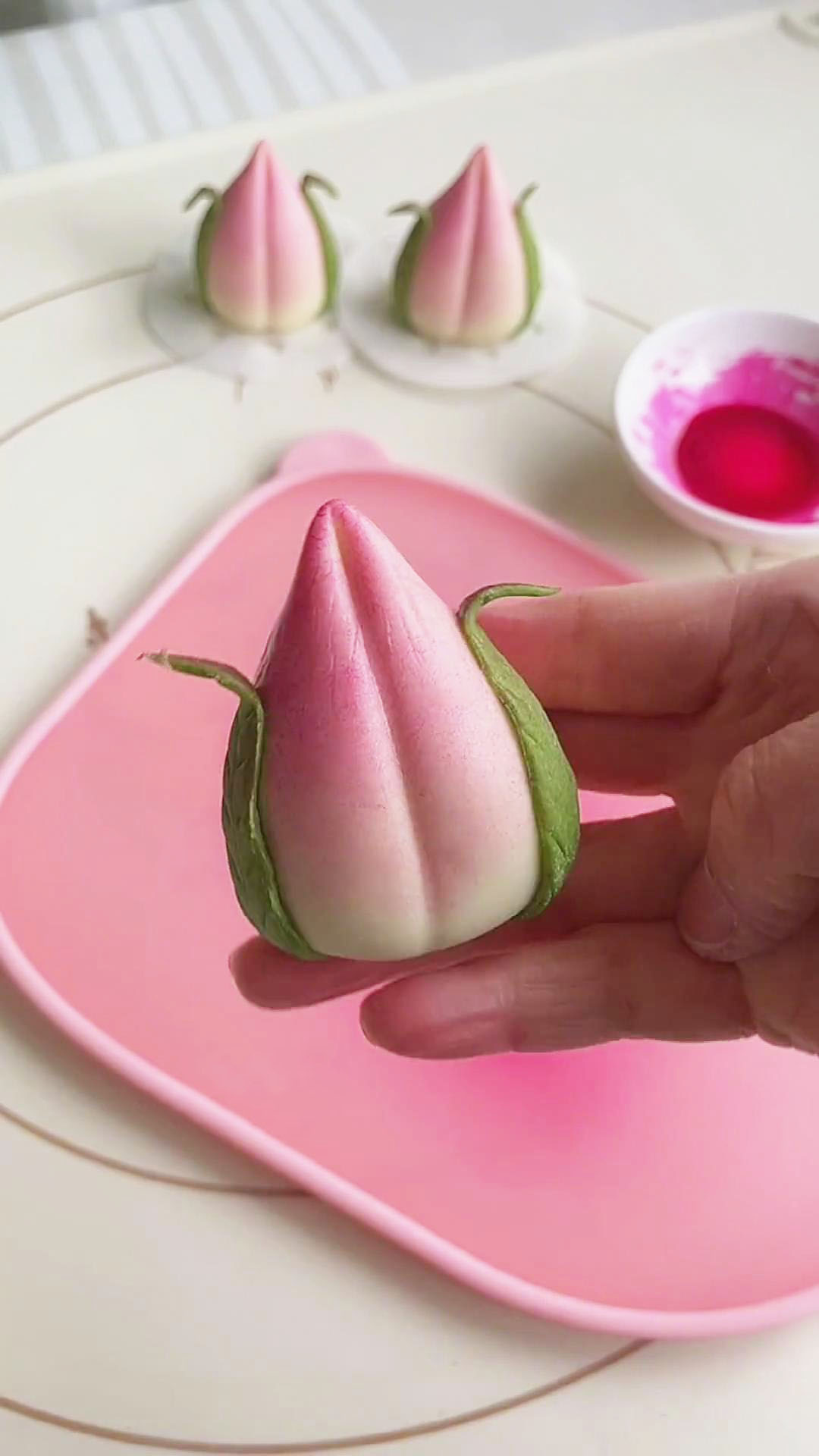
Have you never made buns before? If this is your first time making buns, you should know that there is a proper way of kneading and proofing the buns.
Improper kneading and proofing can give you undesirable results. So, make sure to read my helpful tips and tricks below to create the perfect soft and fluffy bun.
- Get the right dough consistency:
- Measure accurately with a kitchen scale and thermometer. The consistency of the dough can be affected by incorrect measurements. You can use a kitchen weighing scale to make sure you have the right amount of ingredients. If the measurements are inaccurate, the dough may become too runny or stiff.
- If you need to adjust the dough’s consistency, add flour or water. Even if you measure the ingredients with a kitchen weighing scale, the type of flour used might affect the dough’s level of absorption of water. If this happens, add flour or water to adjust the consistency. Don’t overdo it and add small amounts only. If your dough is runny, add more flour, and if your dough is stiff, add more water.
- Don‘t kill the yeast:
- It is also recommended that you use a kitchen thermometer to ensure that the yeast is not killed. Ideally, the water should be below110°F. This rule applies to both warm water for the white dough and spinach juice for the green dough.
- Knead well for smoother texture:
- You should knead with your hands by pressing and folding the dough thoroughly. There should be no air and clumps left in the dough. If there is, it will have air pockets that can cause it to break when steamed.
- Do not over-proof or under-proof:
- Proofing buns usually takes 30 minutes to an hour or more until they reach a size 1.5-2 times larger than their original size.
- You should also avoid over-proofing or under-proofing the dough. Over-proofing will weaken the dough and cause it to crumble. Moreover, it will make the taste sour. On the other hand, under-proofing will not complete the activation process and leave the dough flat.
- It is important to remember that the temperature of your environment affects how fast the proofing process goes. A warmer environment speeds up the proofing process. During cold weather, you can speed up the proofing process by placing the buns in an oven or microwave with boiled water.
- Check for these signs of properly proofed dough:
- Size: After proofing, the buns should be 5 or 2 times bigger than the original size.
- Scent: It should have a natural wheat scent and not smell unpleasant.
- Texture: When pressed, it has a springy or elastic feel. If you lightly press the dough, it should spring back to its original shape.
Things You Need To Make Longevity Peach Bun
The kitchen appliance needed for this recipe is a steamer. Aside from a steamer, you can steam buns without a steamer in 5 techniques: pan with steamer rack, microwave, pan with sieve, rice cooker, and instant pot.
The kitchen items listed below are helpful in making the beautiful peach appearance but are optional.
Kitchen Tools
- Mixing bowls
- Dough cutter or knife
- Leaf mold
- Brush
- Sieve
- Steamer
- Parchment paper
Ingredients:
- 120g red bean paste or your choice of filling
- Water for brushing
- Prickly Pear Fruit Powder (for color)
White Dough:
- 200g all-purpose flour
- 2g yeast
- 110g water
Green Dough:
- 20g all-purpose flour
- 2g yeast
- 12g spinach juice
Detailed Instructions To Make Longevity Peach Bun
You will need to make white dough for the peach base and green dough for the leaves. Combine the two to assemble the peach bun with your choice of filling inside. Watch the detailed steps on my Instagram and TikTok accounts where I post my recipe videos.
Prepare the white dough
- In a mixing bowl, combine all-purpose flour, yeast, and water.
- Knead the mixture until you form a smooth white dough.
Make the green dough
- In a separate bowl, mix all-purpose flour, yeast, and spinach juice to create a green dough.
- Knead until well combined and you form a small green dough.
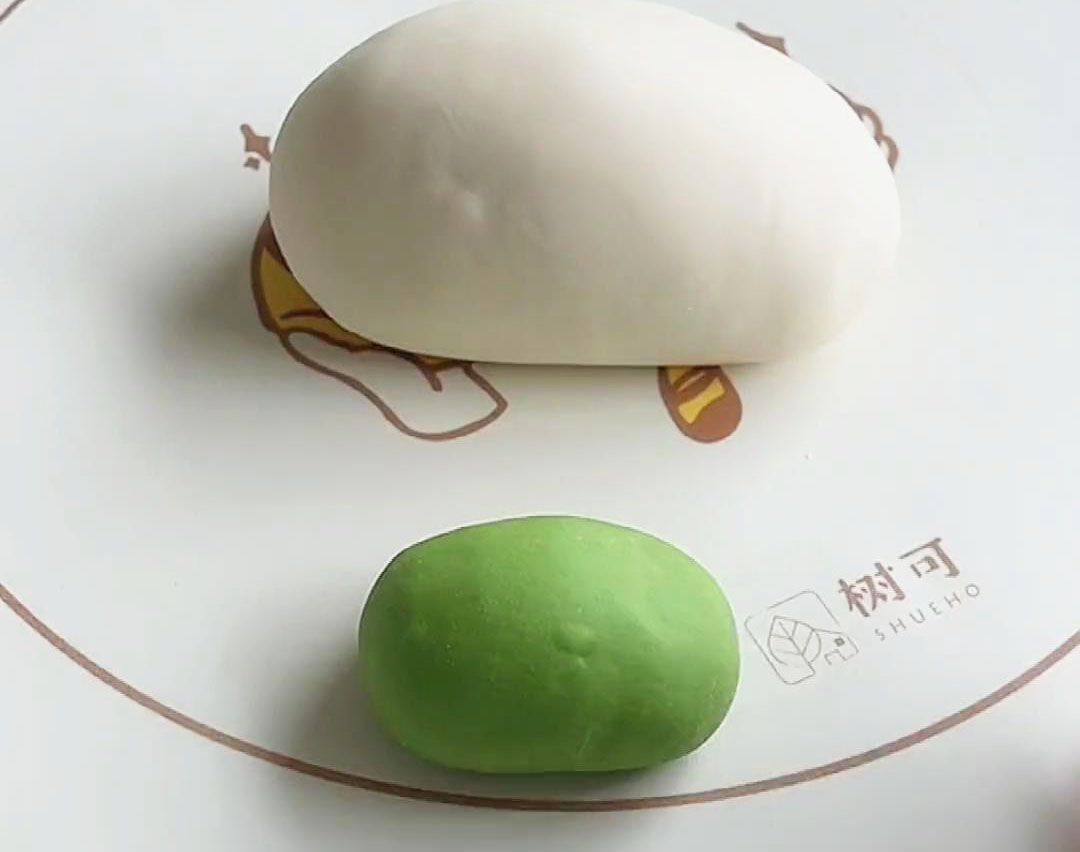
Combine The Dough And Filling
Take a small portion of the white dough and shape it into small round balls. I cut the dough into 8 portions..
Shape the ball into a slightly flat circle. It should still be thick and not thinned out.
At the center of the white dough, place a small amount (about 15g) of red bean paste. There are a variety of fillings you can choose from, including green bean paste, black sesame paste, taro paste, custard, purple sweet potato filling, and lotus paste.
Take the edges of the white dough and pinch them together to seal the red bean paste inside.
Shape the bun into a peach-like form, with a pointed top and a round base.
Gently pinch the top to make a pointed appearance and make a line in the middle using a dough cutter or knife.
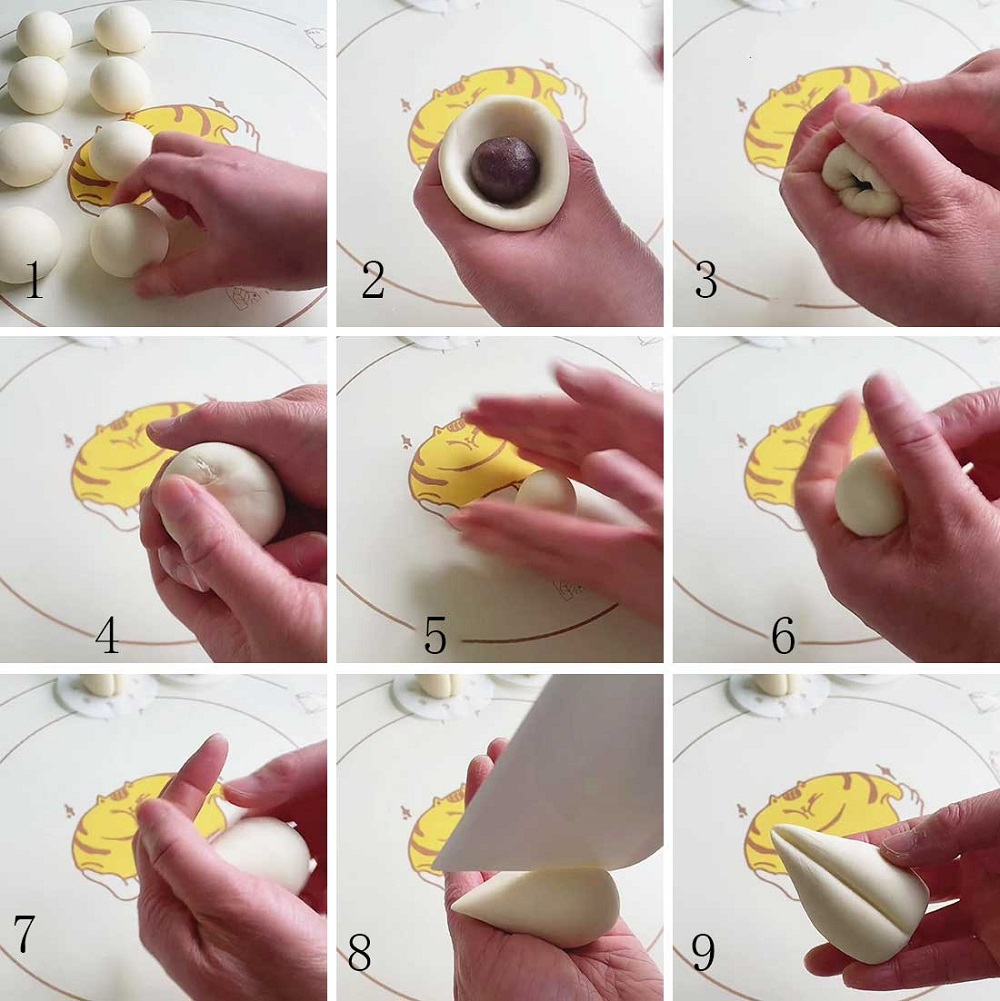
Make leaves from green dough. I used a leaf mold to make this part. You can use any leaf mold you like or create your own by shaping it with a dough cutter or knife.
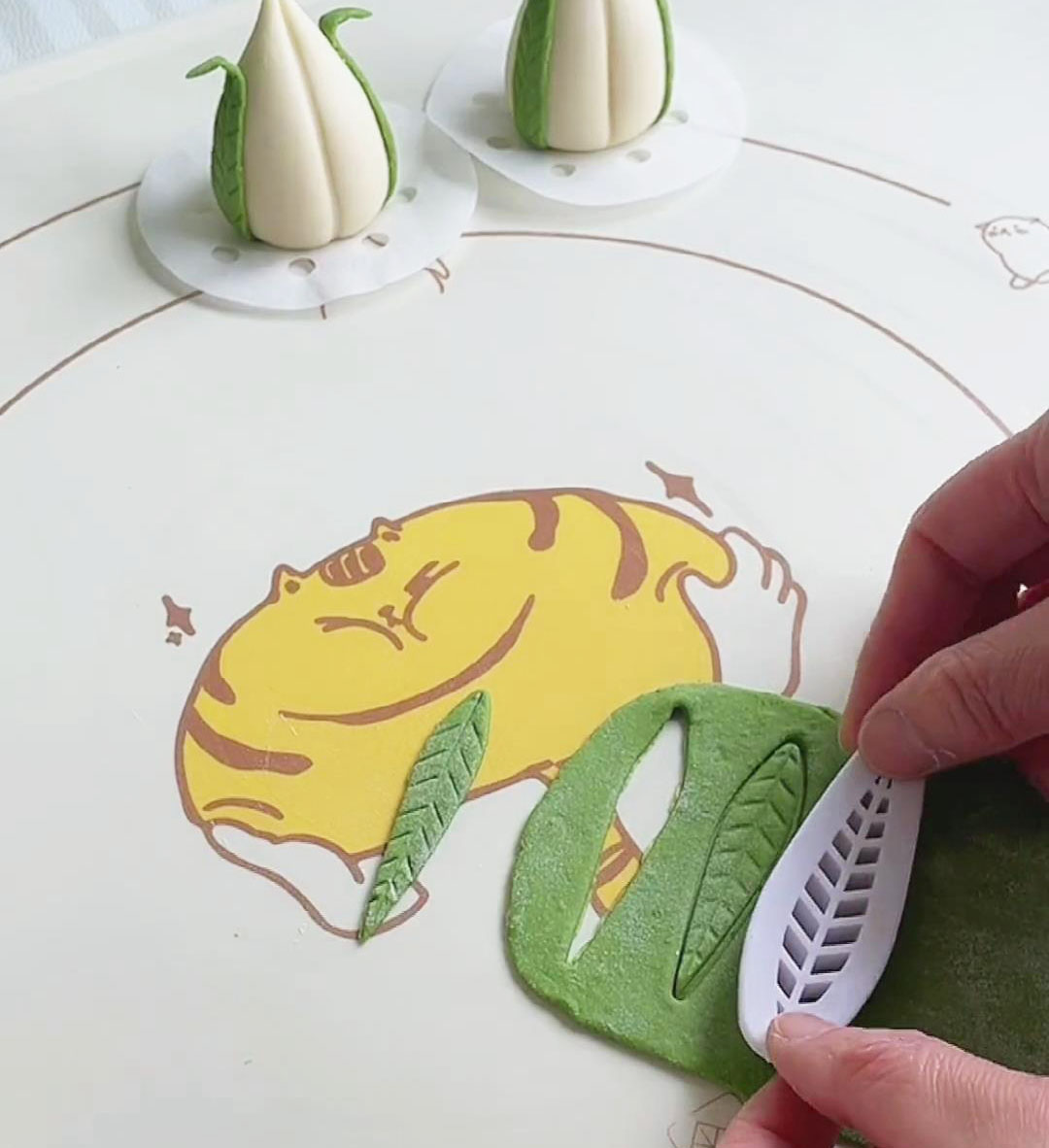
Brush the surface of the bun or green leaves lightly with water. This will make the leaves stick to the white dough better.
Stick green leaves on the sides of the white peach-shaped dough.
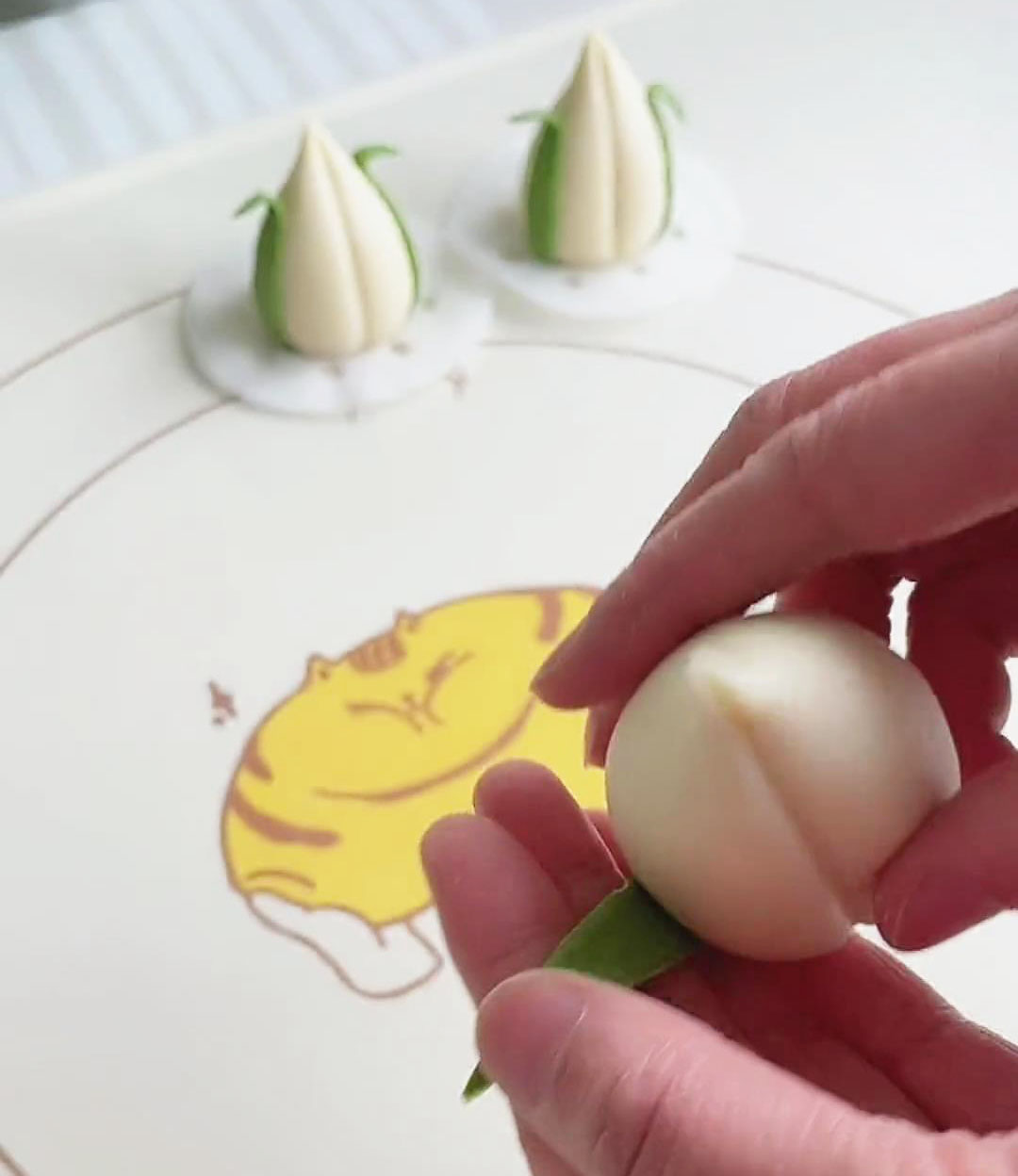
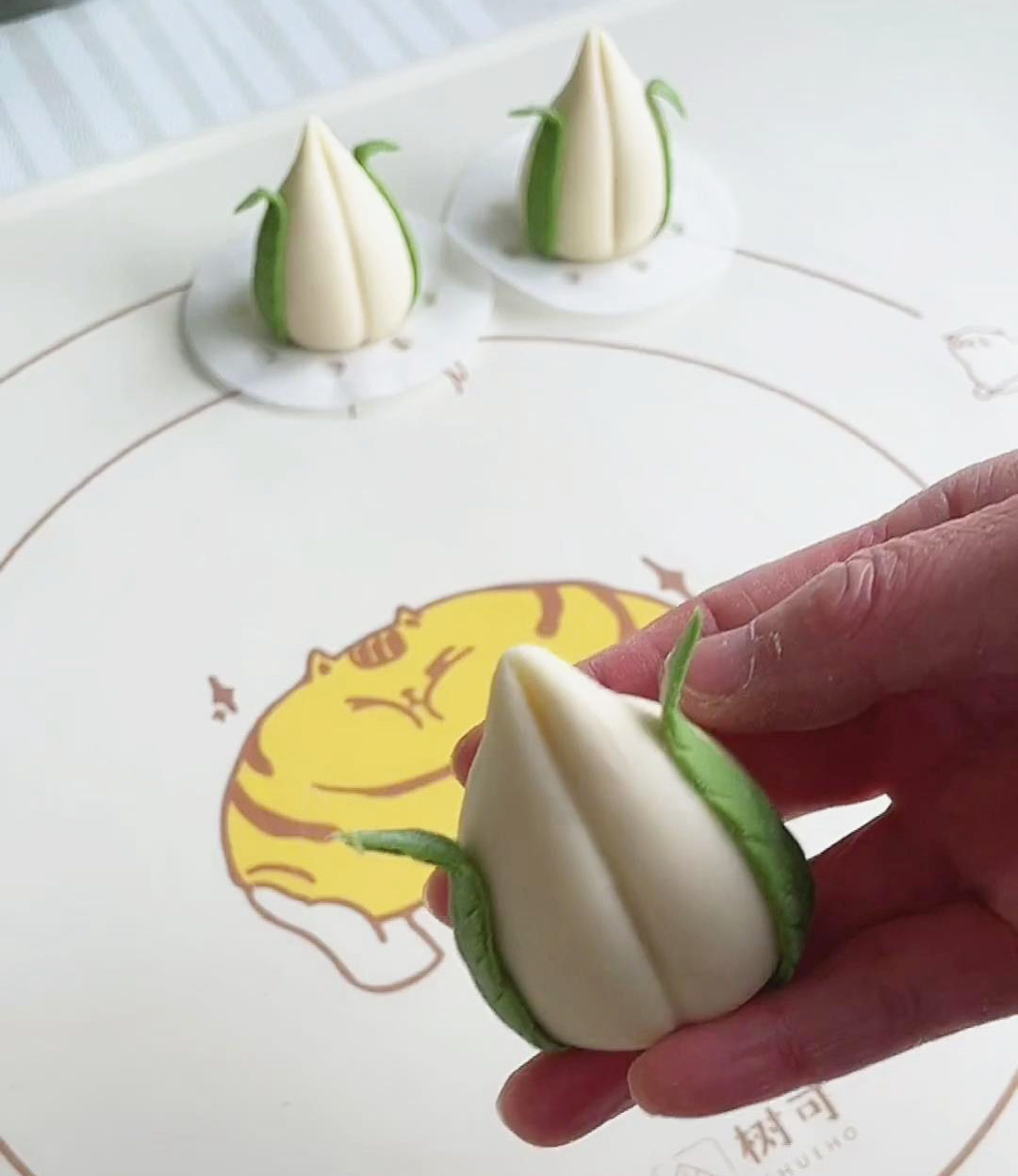
To add a touch of color, dust the bun with a small amount of Prickly Pear Fruit Powder mixed with water. You can use a sieve and a brush for this step. Coat the brush with Prickly Pear Fruit Powder mixed with water and brush it against the sieve with the bun inside.
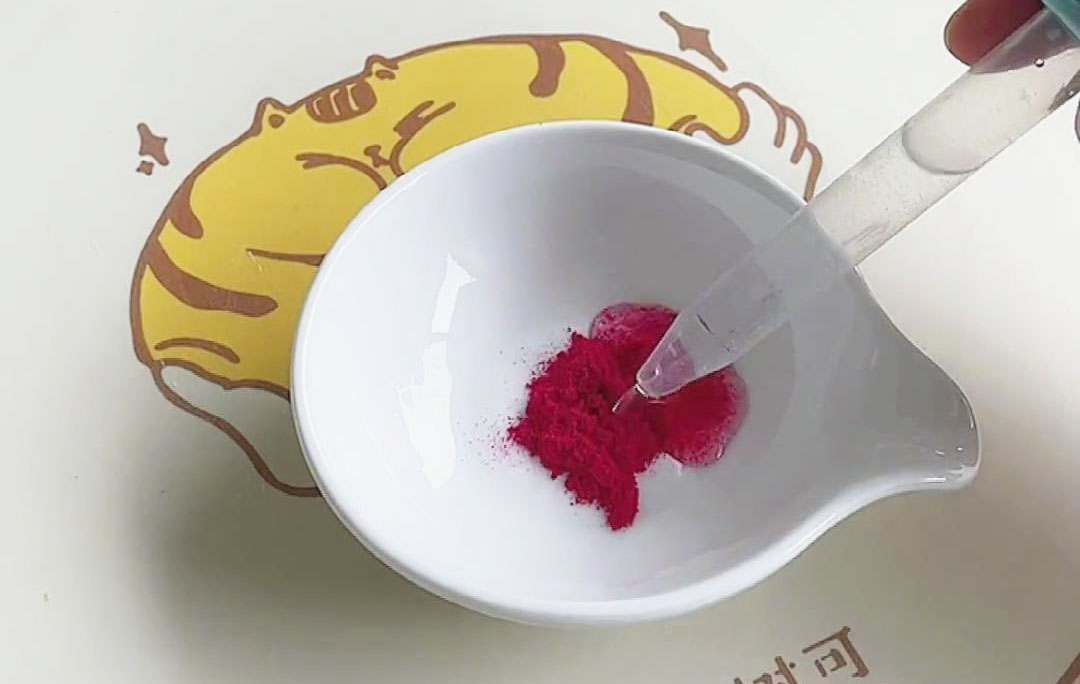

Place the assembled buns in a steamer, allowing them to rise to 1.5 times their original size.
Begin the cooking process with cold water in your steamer. Once the water in the steamer is boiling, steam the buns for approximately 10 minutes.
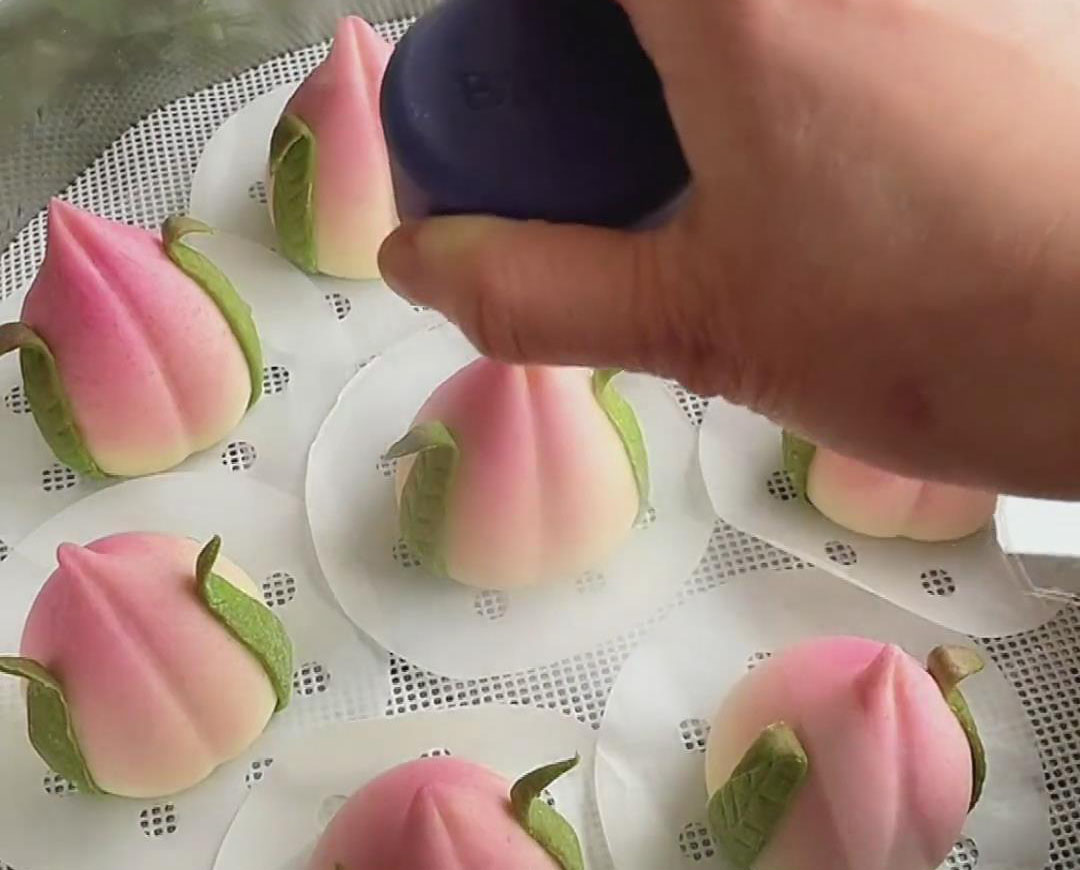
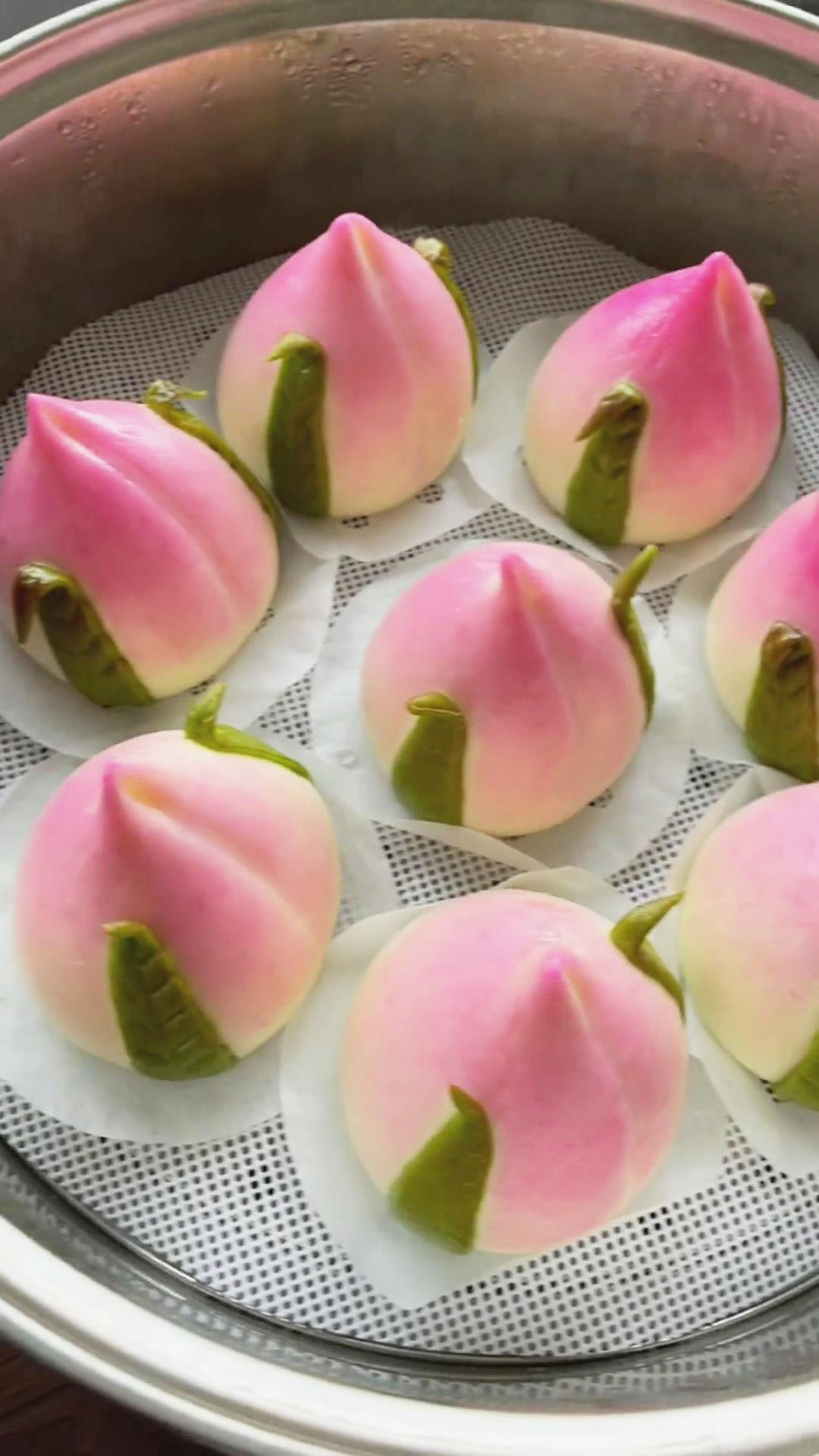
Carefully remove the steamed Longevity Peach Buns from the steamer and let them cool slightly before serving.
If you enjoyed my sweet bun recipe, try my other recipes for a sweet treat, such as sugar bun, steamed taro bun, and purple sweet potato bun. You can also try buns without a filling by making steamed mantou and fried mantou with condensed milk.

Chinese Longevity Peach Buns (寿桃包 - Steamed Shoutao Bao)
Equipment
- Mixing bowls
- Dough cutter or knife
- Leaf mold
- Brush
- Sieve
- Steamer
Ingredients
- 120 g red bean paste or your choice of filling
- Water for brushing
- Prickly Pear Fruit Powder for color
White Dough:
- 200 g all-purpose flour
- 2 g yeast
- 110 g water
Green Dough:
- 20 g all-purpose flour
- 2 g yeast
- 12 g spinach juice
Instructions
Prepare the white dough
- In a mixing bowl, combine all-purpose flour, yeast, and water.
- Knead the mixture until you form a smooth white dough.
Make the green dough
- In a separate bowl, mix all-purpose flour, yeast, and spinach juice to create a green dough.
- Knead until well combined and you form a small green dough.
Combine The Dough And Filling
- Take a small portion of the white dough and shape it into small round balls. I cut the dough into 8 portions..
- Shape the ball into a slightly flat circle. It should still be thick and not thinned out.
- At the center of the white dough, place a small amount (about 15g) of red bean paste. There are a variety of fillings you can choose from, including green bean paste, black sesame paste, taro paste, custard, purple sweet potato filling, and lotus paste.
- Take the edges of the white dough and pinch them together to seal the red bean paste inside.
- Shape the bun into a peach-like form, with a pointed top and a round base.
- Gently pinch the top to make a pointed appearance and make a line in the middle using a dough cutter or knife.
- Make leaves from green dough. I used a leaf mold to make this part. You can use any leaf mold you like or create your own by shaping it with a dough cutter or knife.
- Brush the surface of the bun or green leaves lightly with water. This will make the leaves stick to the white dough better.
- Stick green leaves on the sides of the white peach-shaped dough.
- To add a touch of color, dust the bun with a small amount of Prickly Pear Fruit Powder mixed with water. You can use a sieve and a brush for this step. Coat the brush with Prickly Pear Fruit Powder mixed with water and brush it against the sieve with the bun inside.
- Place the assembled buns in a steamer, allowing them to rise to 1.5 times their original size.
- Begin the cooking process with cold water in your steamer. Once the water in the steamer is boiling, steam the buns for approximately 10 minutes.
- Carefully remove the steamed Longevity Peach Buns from the steamer and let them cool slightly before serving.

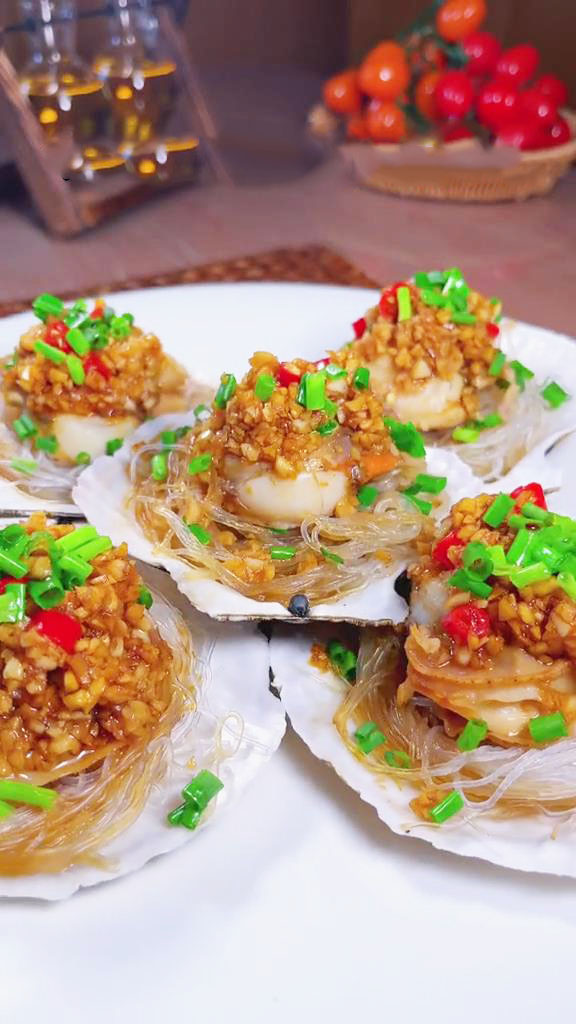
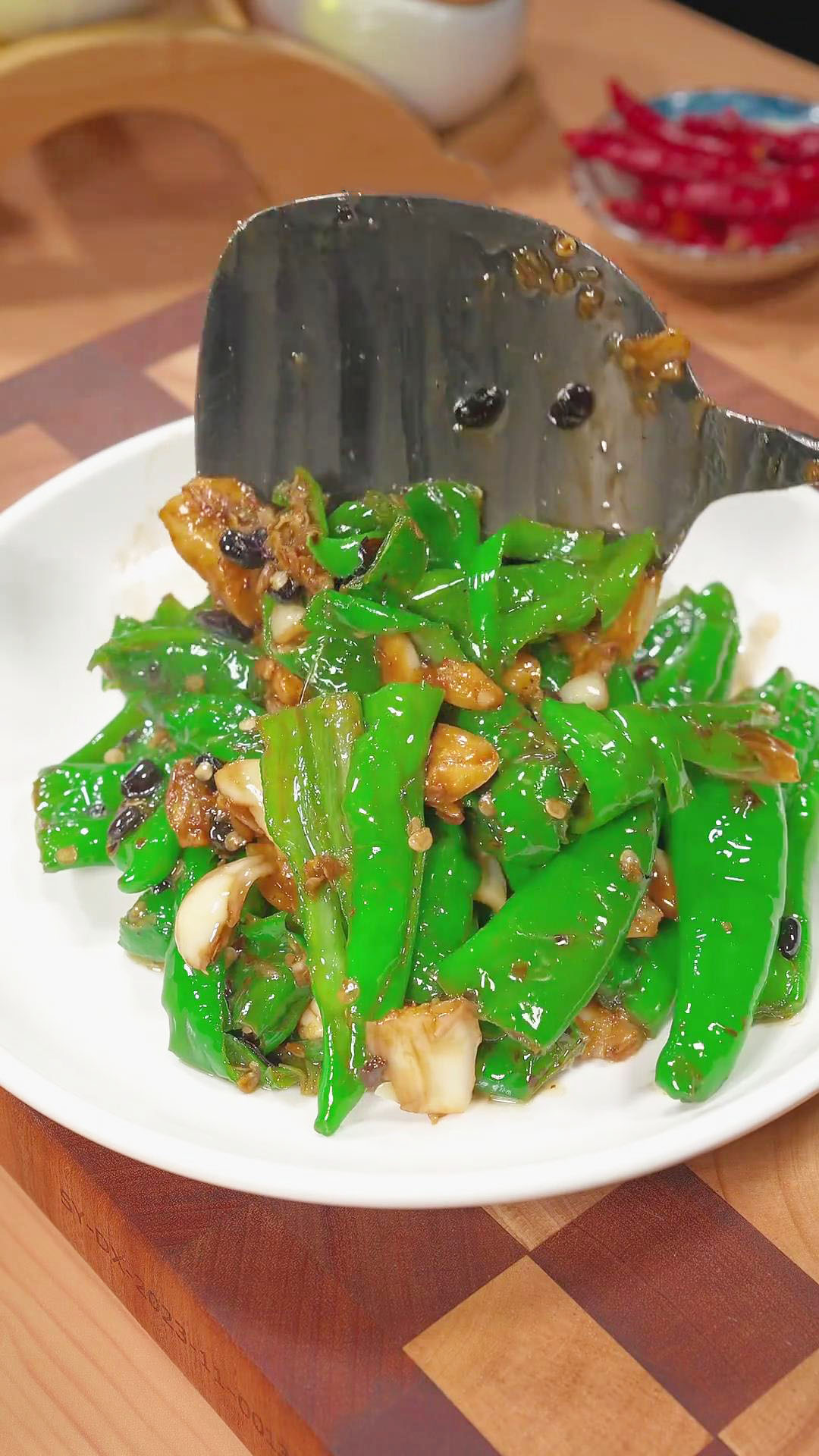
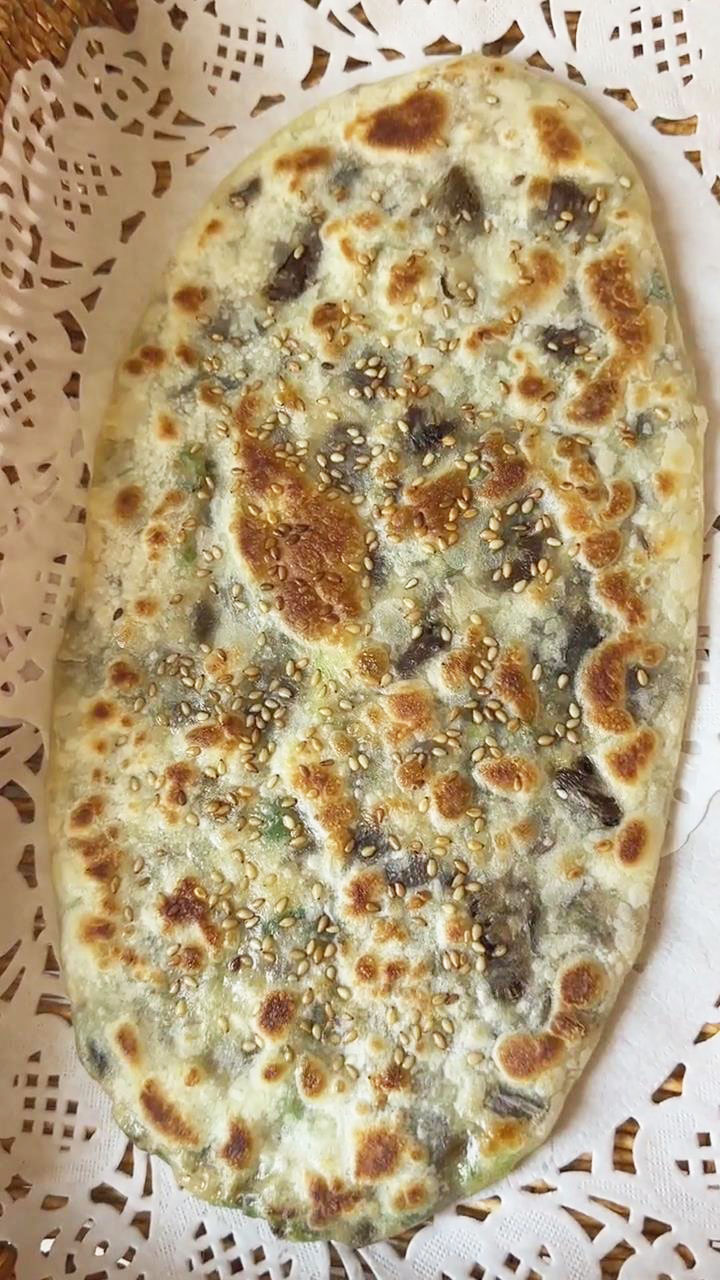
hola, buenas tardes
esta buena tu receta pero no especificaste si hay qeu agregar sal? y que cantidad. saludos desde colombia
Hi Ana,
I didn’t add salt in the recipe, thanks very much.